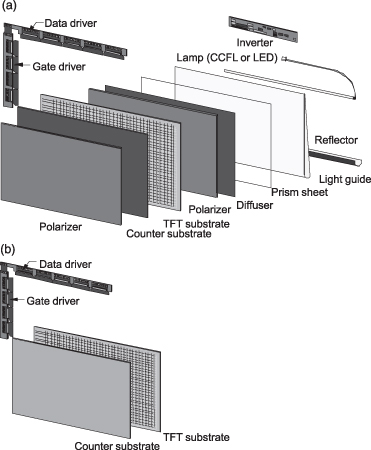4
OLED Display Module
4.1 COMPARISON BETWEEN OLED AND LCD MODULES
Figure 4.1 compares the components that are necessary for production of liquid crystal display (LCD) and OLED display modules.
Figure 4.1 Examples of display components used in LCD (a) and OLED (b) television sets.

An LCD consists of many components because it must convert backlight emission to uniform area emission and switch on and off the light with a liquid crystal shutter, which is positioned between two polarizers.
A typical LCD uses a cold-cathode fluorescent tube (CCFL) or multiple LEDs. Two types of LED are used: (1) that which emits short wavelength emission, which is converted to longer wavelengths by means of a fluorescent material (downconversion) and (2) that which emits the three color primaries (red–green–blue [RGB]). Thus the light source for an LCD is either linear (fluorescent tube) or point, so the light must be converted to the area form to be used as a backlight unit. The light reflected by the reflector passes through the light guide and is diffused. A light guide is made of high refractive index material, such as an acrylic polymer, which delivers the light by total internal reflection due to the refractive index difference between it and the surrounding air. The light guide structure is designed such that uniform luminance distribution across the area of the display can be achieved. Light ...
Get OLED Display Fundamentals and Applications now with the O’Reilly learning platform.
O’Reilly members experience books, live events, courses curated by job role, and more from O’Reilly and nearly 200 top publishers.

